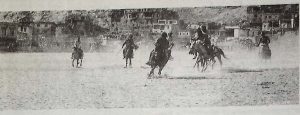

By Special Correspondent in Leh (Ladakh)
Polo was introduced into India by the Muslim conqueror Qutubud din Aibak, who was killed when he fell off his horse while playing polo in 1210. Six centuries after, the British discovered the game in India and gradually changed the nature of this sport. From its conception as a rough, disorganized, warlike spectacle, polo has now evolved into highly sophisticated and refined sport. But there is one place in the world which still does not follow the restraints of the international game with its confining rules and conventions. There are no manicured fields, no fancy crowds. This vigorous game, played with a fanatical fervour, has no yardstick, no boundaries to hamper the game. This is polo in the raw —Ladakhi style with players skirmishing and galloping around the field.
Polo in Ladakh is a novel experience. The field is bare, without semblance of green, blending perfectly into the forbidding backdrop of the Ladakh range, rising to Khardung La, the highest motor able pass in the world, Ancient villages, monasteries ‘and snow clad peaks add their savour to this majestic scene. Lean, hard looking men sit ‘on Zanskari ponies, reputed for their speed, strength, stamina and ability. The forty ‘minute game of 6 players(as against the international 4) has no chukkars (six periods of 71/2 minutes each), It is a free for all as soon as the ball is tossed into the field. Each ‘goal is heralded by the crescendo beat of drums accompanied by horns an essential ingredient of all polo matches in Ladakh. The spectators, mostly Ladakhis, in their dark ‘woollen robes down to the ankles, gathered at the waist with a bright coloured belt, long pointed shoes and cocked hats, add a certain piguancy to the scene
The Ladakh Saraj Polo Tournament held for the first time in 1986, promises to become an annual affair. The tournament was conceived as an attempt to revive traditional form of polo. For the first time teams from Leh area as well as outlying areas such as Kargil, Dras and tuk Tuk were brought in to play. The revival of this form of polo has made this spirited game which has been tersely described as “hockey on horseback” an international event. Cartier, the leading International jewellery firm sponsored the Tournament in 1987, bringing in a retinue of American and European Journalist, cine stars. Including Francesco Quinn, star of Platoon and son of Hollywood Personality, Anthony Quinn.
Leh, the capital of Ladakh is a compact matchbox town of 10,000 people. Situated at the opening of a triangular plateau formed by the Indus. It is an “oases’ surrounded by arid, stark granite mountains. Leh can be reached by a drive from Srinagar over the spectacular Zojila trekking route or simply by air. Only here will one find polo in its rudimental stage an experience that takes on back to the origin of the game that can be traced back to this knot of mountains in Asia.
Article extracted from this publication >> August 26, 1988